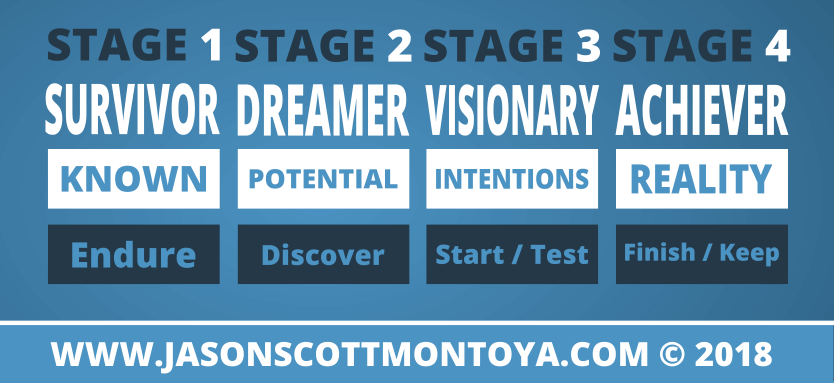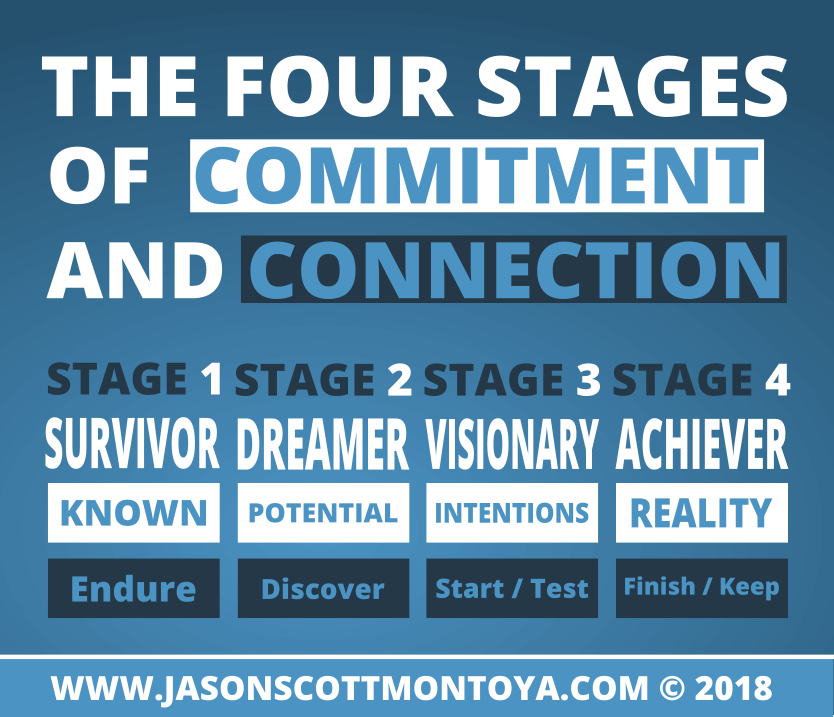
These Four Stages of Commitment Explain How We Interact With The World Around Us
I used to struggle with understanding my commitment level and how to only act at the level of commitment I was comfortable with. After a failed partnership, I discovered a better way to make sense of my commitment and level of connection so I could more effectively navigate partnerships with others going forward. Before I dive in, let's talk about that failed partnership.
In the early years at Noodlehead Marketing, we found ourselves requiring more help than we could afford. An active consultant suggested increasing his engagement in return for partial ownership of the business. He would give us more time to help grow the business and in exchange, we would give him partial ownership of the company. The potential of this idea opened me up to discover it, but I had reservations and instead of bringing me along, the consultant operated as if this proposition was a done deal simply because we talked about it. We never discovered, tested, or formalized the agreement, setting the stage for an inevitable poor ending. And I failed to share my reservations and force the issue to be resolved (reasonably and healthily).
This led to operating beyond my comfort zone. This created an uncomfortable tension that led me to hold back because I was not committed to the level we were moving. This meant I operated with him as if I was only compensating him for his time and not taking the extra time and focus I would have felt comfortable doing knowing he would have ownership in the business. Simply put, if I had committed to it, I would have fully taken advantage of that benefit because I was comfortable paying for it with the business ownership. On the flip side, he operated in reverse, being more proactive and engaged than he would have been if we were simply compensating him for his time.
We had a mismatch in commitment levels and this shaped our actions.
After our working relationship ended (me finally forcing the issue), this issue of ownership quickly surfaced. From his point of view, he invested extra because of the expected return he was planning on receiving. It was a messy situation that ended poorly. While we did reconcile later, it was unfortunate. In retrospect, I take responsibility for what happened and I also want to avoid failing in the same way.
So, in reflection, I sought to understand better what went wrong so I could better navigate my future commitments and partnerships. This exercise led to the following revelation where I discovered the four stages we all go through as an idea moves from concept to reality. And, how our choices, actions, and commitment are inter-connected.
Four Stages of Commitment
It turns out, we humans go through four distinct stages along the commitment spectrum. And by understanding them, we can more effectively engage with ideas and relationships while also helping to more effectively lead others. I've come up with narrative names for each of the four stages to help bring them to life and make them more sticky.
Let’s start by exploring the first of the four stages, the survivor.
1 - Survive
The first stage is before we're aware of the potential of something new. We do what we know. We're committed to what we know, and what we know excludes the new thing (person, venture, project, relationship, etc...). Simply put, we’re doing things the way we know how or how we’re instinctively wired. We’re surviving.
When things get tough, we revert to this survival mode, which, unfortunately, often leads to erecting walls and isolating.
2 - Dream (Imagine)
Somewhere along the way, an idea is introduced that opens us up to the possibilities. We've had enough space from survival mode, that we can start to dream. It's at this moment when we recognize there is potential in exploring what we don't know. We can explore the unknown. When this happens, our commitment migrates from "what we know" to "the potential". This is the dreamer stage. Think of this as the research process in buying something, or when you're interested in pursuing a romantic relationship. As a dreamer, we’re exploring the potential of what this could become. We become an explorer. It could be exploring a business idea or a romantic relationship or it could be something more specific within those categories.
3 - Visioneer (Start)
As we discover "the potential" we'll eventually find a purpose, a strong reason for embracing and starting or testing that potential. We want to go from the dream world to the real world, but not the real world as it is, the real world as we think it is, or want it to be. It’s in this place we become a visionary committing to intentions. Think of this as getting married, starting a business, or drafting a book. We’ve done something to bring to life the ideas in our minds.
But, our conceptions of these things are not based on reality and are influenced by a hybrid of our dreams and a dose of reality. It's one thing to commit to marital vows (in sickness and death) conceptually, but a whole different thing when reality arrives on our doorstep. I had expectations of what entrepreneurship and marriage were going to be like. But the reality was quite different. Visionaries struggle with this dynamic. Life is hard. Business is difficult. Marriage is challenging. And while we start them, we question them once we're knee-deep in reality.
4 - Achieve (Sustain)
As we embrace this commitment to reality further, we’re faced with that reality (positive and negative) that entails the person we married, the business we launched, and the book we began writing. While there was a purpose in making our decision, reality does not match our intentions once we venture down the road.
Embracing this reality and committing to it, is what’s required to reach a fully committed state (Achiever Stage). The achiever accepts both the negative and positive aspects of reality that go along with staying married, having children, continuing their business, or finishing their book and moves forward with realistic expectations of how to fully realize the vision.
“Integrity = The Courage To Meet The Demands of Reality.” Dr. Henry Cloud
And I would add that a wise and healthy achiever engages with reality in a virtuous way. Reality is rough and it will bring us to our knees, but we don't have to become a monster when that happens. We can choose a different, virtuous path.
Those are the four stages of commitment. Let's talk more about connection; the actions we take based on our level of commitment.
Connection
The four stages of commitment start with what we know and the potential of something new, and eventually lead to starting and sustaining a full commitment to something (or someone) new.
A survivor commits to the known and they endure. A dreamer commits to the potential and they explore. A visionary commits to intentions and they test. An achiever commits to the reality and they finish (sustain).
While these stages indicate our level of commitment, there’s also a natural activity that follows the commitment. It’s these responsive activities (connections) that give us the best visibility of what level of commitment we truly hold. They reveal to those around us how committed we truly are.

A survivor endures, a dreamer discovers, a visionary starts (or tests), and an achiever finishes (or keeps/sustains).
Three Tests To Illuminates Commitment Levels
There are simple tests to quickly identify your level of commitment to that project, relationship, or belief.
Let's explore the first, which is a test to differentiate between the first two stages.
Test 1 - Survivor or Dreamer?
The first test is to identify if you are aware and attracted to the potential.
Have you thought about...
- Starting a business?
- Starting a romantic relationship?
- Getting married?
- Writing a book?
- Switching jobs?
If you spent time exploring the idea but have yet to act, you're a dreamer. If you’ve never thought of or been interested in the idea, you're likely a survivor of that path.
In 2016, I had not considered the potential of leaving the church we had been involved with for the previous five years, but when we decided to buy a house, the potential surfaced. As a result, we discovered this potential as part of our first home-purchasing process.
Test 2 - Visionary?
Finding out if someone is a visionary is also quite simple with the right questions. That dream you had, did you take any steps to bring it into reality? Did you start that relationship, begin writing that book, or launch a business? Did you get married?
Here are a few other ways to audit the visionary.
If you're in a romantic relationship and you hit a bump, is your instinct to abandon it and move on? If so, you're likely a visionary who is committed to a vision of the relationship, but not the reality.
If you're a freelancer with no clients and zero dollars in the bank, what's your first thought? Get a job or find a client? If the answer is a job, you’re likely a visionary for freelancing because when it gets challenging you don't seek to overcome the challenge, but seek to find a different path.
This can apply to entrepreneurship. Several years into the Noodlehead Marketing journey, we were way overcommitted. I could easily say yes to everything and had a hard time saying no to anything. Finally, I wrote down a list of all the active and abandoned projects on our plate as a company. With a small team, I was astounded to see, in detail, just how unequipped we were to wisely manage what we had on our plate. We were not operating in reality.
Visionaries are easy to spot because they have a wreckage of incomplete projects, relationships, and initiatives. When new more exciting ventures arise, they stop what’s in front of them and pursue it. Their chronic pattern of abandonment is a major signal of their commitment level. They lack what it takes to follow through consistently and say no to new opportunities. They'll need to come to terms with aspects of reality they cannot get around, but must accept and embrace. And when they do, they'll be more likely to get closer to the vision that have in mind.
If they don't do this, they'll also install an escape hatch on their commitments so they always have a way out if things don't work out. If you have an escape hatch, you'll use it. The adage, burn the boats (or escape hatches), is the shift they'll need to make to most to the next stage.
Test 3 - Achiever?
Action and follow-through are signs of an achiever. They’re like a dog with a bone that won’t let go.
When we ask the achiever freelancer what they'll do when they lose all their clients and their bank account runs dry, they’ll seek out the next client when money is gone and income has dried up. When a spouse is having trouble in a marriage, they don't think of a way out, they think of ideas on how they can improve themselves and the relationship. If they can't figure it out themselves, they ask for help and bring in support.
Someone fully committed will keep going regardless of failure or success.
A writer who doesn’t get the traction she hopes or expects, keeps writing. An achiever writer would write if she was the only one to ever read it. An achiever writer also continues when he has succeeded. When the livelihood does not depend on the writing, this acts as another helpful test of how committed that person is to the endeavor or relationship. Will you keep doing the thing even when you do not get paid to do it?
These real achiever life-tests act as a way to identify if the focus of our commitment is the thing we say it is, or the benefits that come along with it.
The achiever in marriage is someone who, when facing sickness and death in their marriage, sticks with it. I remember going through all the worst-case scenarios about my marriage and wife and mentally preparing and accepting these realities. What if my wife became paralyzed in a tragic car accident? Would I stay with her or abandon the marriage? Because of my Christian faith, I wanted to be the type of husband that no matter what unfolded, I could fulfill my commitment.
Clarity On Our Commitment Level Helps Us Move In The Right Direction
When we’re interacting with other people, it’s insightful to understand where we and others are at in the progression. This understanding helps us know the wise next step and empowers us to facilitate, not force others along. When we move to a stage of commitment and connection, and the other person does not match us, they have a tension to go back when we want to go forward. And eventually, it'll snap, like my business partnership did.
But, there is a healthy way forward. Let’s say two people want to launch a business together but one is a dreamer and the other is a visionary. The visionary can help the dreamer discover the details she’s missing to move to the next stage. And if they struggle to do this, they can bring in help to do this or figure out they are being unreasonable or unrealistic. We all have blind spots and sometimes we need to help to see them.
With an achiever and visionary are in a romantic relationship, problems can quickly surface when the achiever pulls the visionary to move the relationship forward before the other is ready. This could be financial decisions, community choices, or intimate experiences. Often we can manipulate, control, and escalate things to coerce them forward, instead of bringing them along and working out their objections which may sometimes require that we change what we want. Virtue becomes important because we can easily become monsters when we don't get what we want. The healthy achiever can help the visionary get clarity and focus on any roadblocks preventing the visionary from taking the next steps. And they can wait (have patience) and change where those roadblocks seem unmovable.
When it comes to pursuing our ideas, including aspirations, relationships, and hobbies, clarity on these stages can help us move forward and set up accountability with people who love us. When we hit major roadblocks, we usually can’t move forward on our own. We need help.
Ultimately, the possibilities are endless with how you can leverage this insightful little tool called the four stages of commitment & connection. It includes your personal commitments, your romantic relationships, and it can also involve a group of people you want to lead.
And to have the most success, we'll want to best understand reality, and communicate that reality on the front end of the pursuit, relationship, or partnership. This allows everyone involved to know what they are getting into before it begins.
These four stages are the undergirding foundation of the Island Story. If this system intrigues you, I recommend exploring the story and storytelling framework.

Hero Photo by Annie Spratt on Unsplash
The Island Story, Stages of Commitment
- Created on .
- Last updated on .